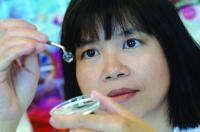Researchers use artificial corneas to restore sight
by
Brendon Nafziger, DOTmed News Associate Editor | August 26, 2010

Dr. May Griffith shows
off the biosynthetic
cornea. (Courtesy
Ottawa Hospital Research
Institute )
Researchers in Canada and Sweden have restored sight in half a dozen patients using biosynthetic corneas. The artificial corneas, made of synthetic collagen and recruited host cells, could help alleviate a human donor shortage and the need for immunosuppressant drugs after transplant, the researchers said.
While plastic corneas have sometimes been used in cornea transplants when donor tissue wasn't available or recommended, the fake corneas did not allow nerve tissue regeneration, according to FibroGen Inc., the San Francisco-based company that developed the collagen technology.
"This study is important because it is the first to show that an artificially fabricated cornea can integrate with the human eye and stimulate regeneration," senior author Dr. May Griffith said in a statement. "With further research, this approach could help restore sight to millions of people who are waiting for a donated human cornea for transplantation."
Griffith, a scientist with the Ottawa Hospital Research Institute, professor of medicine at the University of Ottawa, and director of the Integrative Regenerative Medicine Center at Linkoping University, collaborated with her Linkoping colleague Dr. Per Fagerholm, an eye surgeon at the university.
Fagerholm and his team implanted the new corneas in around 10 Swedish patients. The team recruited patients who had suffered keratoconus, a bulging of the cornea, or corneal scarring.
Two years after the implant surgery, the patients had a blink reflex, produced tears and for nine of the patients, there was nerve regeneration through the implant.
Around six of the implant patients had improved vision, two had unchanged vision, and two had deterioration, according to the study, which appeared in the Aug. 25 issue of Science Translational Medicine.
Nonetheless, when compared with 60 patients who had cornea transplants from human donors, the spectacle-corrected vision for the synthetic-cornea patients was worse. But if they swapped specs for rigid contact lenses, visual acuity for synthetic-cornea patients was nearly the same, according to the study.
Equally significant, none of the patients required long-term use of immunosuppressive steroid drugs, according to the researchers.
The synthetic corneas were molded from recombinant human type III collagen made by FibroGen. This collagen extracellular matrix then recruits the host's own cells to make a functional cornea.
Most U.S. patients who need a cornea transplant have a waiting time of only around three weeks, The Eye-Bank for Sight Restoration in New York, told DOTmed News.
